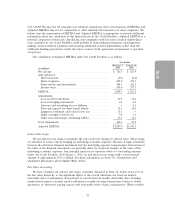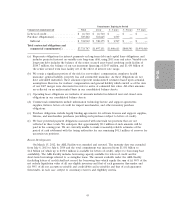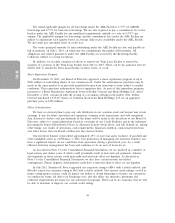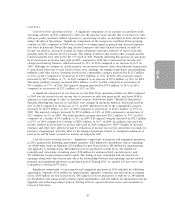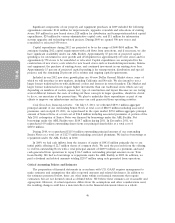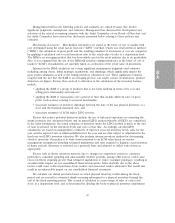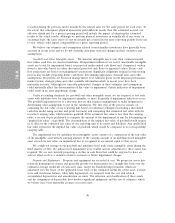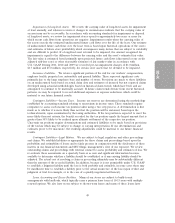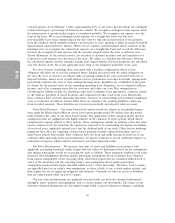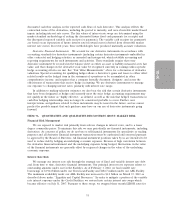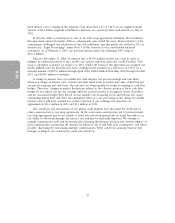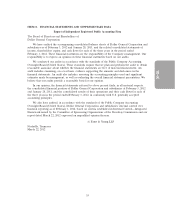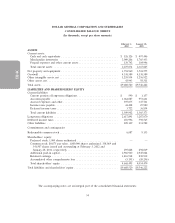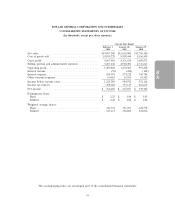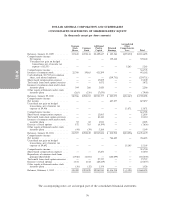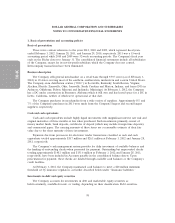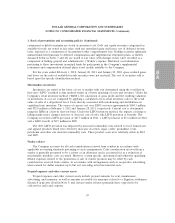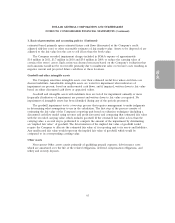Dollar General 2011 Annual Report Download - page 151
Download and view the complete annual report
Please find page 151 of the 2011 Dollar General annual report below. You can navigate through the pages in the report by either clicking on the pages listed below, or by using the keyword search tool below to find specific information within the annual report.
10-K
discounted cash flow analysis on the expected cash flows of each derivative. This analysis reflects the
contractual terms of the derivatives, including the period to maturity, and uses observable market-based
inputs, including interest rate curves. The fair values of interest rate swaps are determined using the
market standard methodology of netting the discounted future fixed cash payments (or receipts) and
the discounted expected variable cash receipts (or payments). The variable cash receipts (or payments)
are based on an expectation of future interest rates (forward curves) derived from observable market
interest rate curves. In recent years, these methodologies have produced materially accurate valuations.
Derivative Financial Instruments. We account for our derivative instruments in accordance with
accounting standards for derivative instruments (including certain derivative instruments embedded in
other contracts) and hedging activities, as amended and interpreted, which establish accounting and
reporting requirements for such instruments and activities. These standards require that every
derivative instrument be recorded in the balance sheet as either an asset or liability measured at its fair
value, and that changes in the derivative’s fair value be recognized currently in earnings unless specific
hedge accounting criteria are met. See ‘‘Fair Value Measurements’’ above for a discussion of derivative
valuations. Special accounting for qualifying hedges allows a derivative’s gains and losses to either offset
related results on the hedged item in the statement of operations or be accumulated in other
comprehensive income, and requires that a company formally document, designate, and assess the
effectiveness of transactions that receive hedge accounting. We use derivative instruments to manage
our exposure to changing interest rates, primarily with interest rate swaps.
In addition to making valuation estimates, we also bear the risk that certain derivative instruments
that have been designated as hedges and currently meet the strict hedge accounting requirements may
not qualify in the future as ‘‘highly effective,’’ as defined, as well as the risk that hedged transactions in
cash flow hedging relationships may no longer be considered probable to occur. Further, new
interpretations and guidance related to these instruments may be issued in the future, and we cannot
predict the possible impact that such guidance may have on our use of derivative instruments going
forward.
ITEM 7A. QUANTITATIVE AND QUALITATIVE DISCLOSURES ABOUT MARKET RISK
Financial Risk Management
We are exposed to market risk primarily from adverse changes in interest rates, and to a lesser
degree commodity prices. To minimize this risk, we may periodically use financial instruments, including
derivatives. As a matter of policy, we do not buy or sell financial instruments for speculative or trading
purposes and all derivative financial instrument transactions must be authorized and executed pursuant
to approval by the Board of Directors. All financial instrument positions taken by us are intended to be
used to reduce risk by hedging an underlying economic exposure. Because of high correlation between
the derivative financial instrument and the underlying exposure being hedged, fluctuations in the value
of the financial instruments are generally offset by reciprocal changes in the value of the underlying
economic exposure.
Interest Rate Risk
We manage our interest rate risk through the strategic use of fixed and variable interest rate debt
and, from time to time, derivative financial instruments. Our principal interest rate exposure relates to
outstanding amounts under our Credit Facilities. As of February 3, 2012, we had variable rate
borrowings of $1.964 billion under our Term Loan Facility and $184.7 million under our ABL Facility.
The maximum availability under our ABL Facility was increased to $1.2 billion on March 15, 2012 as
described above under ‘‘Liquidity and Capital Resources.’’ In order to mitigate a portion of the variable
rate interest exposure under the Credit Facilities, we entered into certain interest rate swaps which
became effective on July 31, 2007. Pursuant to these swaps, we swapped three month LIBOR rates for
51


